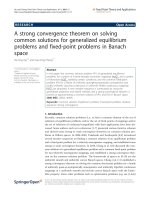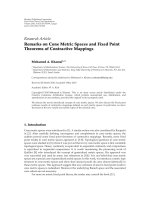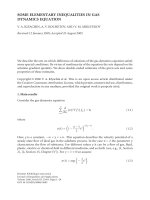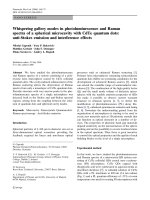Báo cáo hóa học: " A CONTRACTION THEOREM IN FUZZY METRIC SPACES" doc
Bạn đang xem bản rút gọn của tài liệu. Xem và tải ngay bản đầy đủ của tài liệu tại đây (502.37 KB, 9 trang )
A CONTRACTION THEOREM IN FUZZY METRIC SPACES
ABDOLRAHMAN RAZANI
Received 3 January 2005 and in revised form 7 April 2005
A fixed point theorem is proved. Moreover, fuzzy Edelstein’s contraction theorem is de-
scribed. Finally, the existence of at least one periodic point is shown.
1. Introduction
After Zadeh pioneering’s paper [15], where the Theory of Fuzzy Sets was introduced,
hundreds of examples have been supplied where the nature of uncertaint y in the behav-
ior of a given system possesses fuzzy rather than stochastic nature. Non-stationary fuzzy
systems described by fuzzy processes look as their natural extension into the time domina.
From different viewpoints they were carefully studied.
Fixed-point theory for contraction type mappings in fuzzy metric space is closely re-
lated to the fixed-point theory for the same type of mappings in probabilistic metric
space of Menger type (see [10, 13]). The concept of fuzzy metric spaces recently have
been int roduced in different ways by many authors [1, 2, 8]. George and Veeramani [3, 4]
modified the concept of fuzzy met ric space which has been introduced by Kramosil and
Mich
´
alek [9] and obtained a Hausdorff topology for this kind of fuzzy metric space.
Here, we claim that if (X,M,
∗) is a fuzzy metric space, and A acontractivemapping
of X into itself such that there exists a point x ∈ X whose sequence of iterates (A
n
(x))
contains a convergent subsequence (A
n
i
(x)); then ξ = lim
i→∞
A
n
i
(x) ∈ X is a unique fixed
point. In addition, we can prove fuzzy Edelstein’s contraction theorem. Note that this
happen when we consider the fuzzy metric space in the George and Veeramani’s sense.
In addition, it is claimed that fuzzy Edelstein’s contraction theorem is true whenever we
consider the fuzzy metric space in the Kramosil and Mich
´
alek’s sense. Finally, the exis-
tence of at least one periodic point will be proved and two question would arise. In order
to do this, we recall some concepts and results that will be required in the sequel.
Definit ion 1.1 [12]. A binary operation
∗ :[0,1× [0,1] → [0,1]isacontinuoust-norm if
([0,1],∗)isatopologicalmonoidwithunit1suchthata ∗ b ≤ c ∗ d whenever a ≤ c and
b ≤ d,anda,b,c,d ∈ [0,1].
Copyright © 2005 Hindawi Publishing Corporation
Fixed Point Theory and Applications 2005:3 (2005) 257–265
DOI: 10.1155/FPTA.2005.257
258 A contraction theorem in fuzzy metric spaces
Definit ion 1.2 [3]. The 3-tuple (X,M,∗) is said to be a fuzzy metric space if X is an
arbitr ary set, ∗ is a continuous t-norm and M is a fuzzy set on X
2
×]0,∞[ satisfying the
following conditions: for all x, y, z ∈ X and t,s>0,
(i) M(x, y,t) > 0,
(ii) M(x, y,t) = 1ifandonlyifx = y,
(iii) M(x, y,t) = M(y,x,t),
(iv) M(x, y, t) ∗ M(y,z,s) ≤ M(x,z,t + s),
(v) M(x, y,·):]0,∞[→ [0,1] is continuous.
Lemma 1.3 [5]. M(x, y,·) is nondecreasing for all x, y ∈ X.
In order to introduce a Hausdorff topology on the fuzzy metric space, the following
definitions are needed.
Definit ion 1.4 [3]. Let (X, M,∗) be a fuzzy metric space. The open ball B(x,r,t)fort>0
with center x ∈ X and radius r,0<r<1, is defined as B(x,r,t) ={y ∈ X : M(x, y, t) >
1 − r}. The family {B(x,r,t):x ∈ X,0<r<1, t>0} is a neighborhood’s system for a
Hausdorff topology on X, that we call induced by the fuzzy metric M.
Definit ion 1.5 [3]. In a metric space (X,d), the 3-tuple (X,M
d
,∗)whereM
d
(x, y,t) =
t/t + d(x, y)anda ∗ b = ab, is a fuzzy metric space. This M
d
is called the standard fuzzy
metric induced by d.
The topologies induced by the standard fuzzy metric and the corresponding metric
are the same.
Theorem 1.6 [3]. Asequence(x
n
) in a fuzzy metric space (X,M,∗) converges to x if and
only if M(x
n
,x,t) → 1 as n →∞.
Definit ion 1.7 [3]. A sequence (x
n
) in a fuzzy metric space (X,M,∗) is a Cauchy sequence
if and only if for each ε ∈ (0,1) and each t>0, there exists n
0
∈ N such that M(x
n
,x
m
,t) >
1 − ε for all n,m ≥ n
0
.
A fuzzy metric space in which every Cauchy sequence is convergent is called a complete
fuzzy metric space.
Lemma 1.8 [7]. In a fuzzy metric space (X,M,∗),foranyr ∈ (0,1) there exists an s ∈ (0,1)
such that s∗ s ≥ r.
Lemma 1.9 [11]. Let (X,M,∗) be a fuzzy metric space. Then M is a continuous function on
X × X × (0,+∞).
George and Veeramani [3] proved that every fuzzy metric M on X generates a topology
τ
M
on X. In addition, they showed that (X,τ
M
)isaHousdorff first countable topological
space. Moreover, if (X,d) is a metric space, then the topology generated by d coincides
with the topology τ
M
d
generated by the induced fuzzy metric M
d
.
Definit ion 1.10 [6]. A fuzzy metr ic space (X,M,∗) is called precompact if for each 0 <
r<1, and each t>0, there is a finite subset A of X,suchthatX =
a∈A
B(a,r,t). In this
case, we say that M is a precompact fuzzy metric on X.
Abdolrahman Razani 259
Theorem 1.11 [6]. A fuzzy me tric space is percompact if and only if every sequence has a
Cauchy subsequence.
Definit ion 1.12 [6]. A fuzzy metric space (X,M,∗)iscalledcompactif(X,τ
M
)isacom-
pact topological space.
Theorem 1.13 [6]. A fuzzy metric space is compact if and only if it is precompact and
complete.
Definit ion 1.14 [7]. Let (X,M,∗) be a fuzzy metric space. We call the mapping f : X → X
fuzzy contractive mapping, if there exists k ∈ (0,1) such that
1
M
f (x), f (y),t
− 1 ≤ k
1
M(x, y,t)
− 1
, (1.1)
for each x = y ∈ X and t>0, (k is called the contractive constant of f ).
Proposition 1.15 [7]. Let (X,M,∗) be a fuzzy metric space. If f : X → X is fuzzy contrac-
tive mapping then f is t-uniformly continuous.
Grabiec [5] proved a fuzzy Banach contraction theorem whenever fuzzy metric space
was considered in the sense of Kramosil and Mich
´
alek and was complete in Grabiec’s
sense. Then Vasuki [14] generalized Grabiec’s result for common fixe d point theorem
for a sequence of mapping in a fuzzy metric space. Gregori and Sapena [7]gavefixed
point theorems for complete fuzzy metric space in the sense of George and Veeramani,
and also for Kramosil and Mich
´
alek’s fuzzy metric space which are complete in Grabiec’s
sense. George and Veeramani [3] have pointed out that the definition of Cauchy sequence
given by Grabiec is weaker and hence it is essential to modify that definition to get better
results in fuzzy metric space. Finally,
ˇ
Ziki
´
c[16] proved that the fixed point theorem of
Gregori and Sapena holds under more general conditions (theory of countable extension
of a t-norm).
In the next section, we are concerned with the implications of modifications in the
assumptions. Exactly, in the absence of completeness of the space, we obtain some infor-
mation on the convergence of a sequence of iterates. Finally, fuzzy Edelstein’s theorem is
proved for the fuzzy metric space in the George and Veeramani’s sense.
2. Fixed point under contractive map
In this section, the definition of contractive map is rewritten and an iterative theorem is
proved. In fact, this theorem shows the existence of a fixed point of a contractive map. In
order to do this, we recall Definition 1.14 as follows:
Definit ion 2.1. Let (X,M,
∗) be a fuzzy metric space. We call the mapping f : X → X fuzzy
contractive mapping, if
1
M
f (x), f (y),t
− 1 <
1
M(x, y,t)
− 1
, (2.1)
260 A contraction theorem in fuzzy metric spaces
for each x = y ∈ X and t>0, or we call f : X → X fuzzy contractive mapping, if
M
f (x), f (y),t
>M(x, y,t), (2.2)
for each x = y ∈ X and t>0.
Theorem 2.2. Let (X,M,∗) be a fuzzy metric space, and A a fuzzy contractive mapping of
X into itself such that there exists a point x ∈ X whosesequenceofiterates(A
n
(x)) contains
a convergent subsequence (A
n
i
(x)); then ξ = lim
i→∞
A
n
i
(x) ∈ X isauniquefixedpoint.
Proof. Suppose A(ξ) = ξ and consider the sequence (A
n
i
+1
(x)) which, it can easily be
verified, converges to A(ξ).
For any fixed t ∈ (0,+∞), the mapping r(p, q)ofY = X × X into the real line defined
by
r(p, q) =
M
A(p),A(q),t
M(p,q,t)
. (2.3)
Note that A is a fuzzy contractive mapping of X into itself, and also Lemma 1.9 shows
that M is continuous on X × X × (0,+∞). Thus r is a continuous function on Y. This
shows that there exists a neighborhood U of (ξ,A(ξ)) ∈ Y such that p,q ∈ U implies
1 <R<r(p,q). (2.4)
Let B
1
= B
1
(ξ, ρ,t)andB
2
= B
2
(A(ξ), ρ,t) be open neighborhoods centered at ξ and A(ξ),
respectively, and of radius ρ>0 small enough such that B
1
B
2
= Φ and B
1
× B
2
⊂ U.
By the assumption there exists a positive integer N such that i>Nimplies A
n
i
(x) ∈ B
1
and hence by (2.2)alsoA
n
i
+1
(x) ∈ B
2
. On the other hand, for such i,itfollowsfrom(2.3)
and (2.4)that
M
A
n
i
+1
(x), A
n
i
+2
(x), t
>RM
A
n
i
(x), A
n
i
+1
(x), t
. (2.5)
Arepeateduseof(2.5)forl>j>Nnow gives
M
A
n
l
(x), A
n
l
+1
(x), t
≥ M
A
n
l−1
+1
(x), A
n
l−1
+2
(x), t
>RM
A
n
l−1
(x), A
n
l−1
+1
(x), t
≥···
>R
l− j
M
A
n
j
(x), A
n
j
+1
(x), t
−→ ∞ ,asl −→ ∞ .
(2.6)
Which is contradiction with the property (v) of fuzzy metric ( M,
∗)inDefinition 1.2.
Thus A(ξ) = ξ and this means that ξ is a fixed point of A.
Abdolrahman Razani 261
In order to prove the uniqueness of ξ,supposethereisanη = ξ with A(η) = η,thenit
follows that
M(ξ,η,t) = M
A(ξ), A(η),t
>M(ξ,η, t), (2.7)
which is contradiction. This proves the uniqueness and, thus, accomplishes the proof of
this theorem.
Theorem 2.2 will imply some information on the convergence of sequence of iterates.
Remark 2.3. Let all assumptions of Theorem 2.2 hold. If (A
n
(x)), x ∈ X, contains a
convergent subsequence (A
n
i
(x)), then lim
n→∞
A
n
(x) exists and coincides with the fixed
point ξ.
Proof. By Theorem 2.2 we have lim
i→∞
A
n
i
(x) = ξ.Given1>δ>0 there exists, then, a
positive integers N
0
such that i>N
0
implies M(ξ,A
n
i
(x), t) > 1 − δ.Ifm = n
i
+ l (n
i
fixed,
l variable) is any positive integer >n
i
then
M
ξ, A
m
(x), t
= M
A
l
(ξ), A
n
i
+l
(x), t
>M
ξ, A
n
i
(x), t
> 1 − δ, (2.8)
which proves the above assertion.
Due to Theorems 1.11 and 1.13, in the fuzzy compact spaces, the following condition
there exists a point x ∈ X whose sequence of iterates
A
n
(x)
contains a convergent subsequence
A
n
i
(x)
(2.9)
is always satisfied. Thus fuzzy Edelstein’s contractive theorem is as follows.
Remark 2.4. If X is a fuzzy compact space and A is a contractive self-mapping on X then
there exists a unique fixed point of A.
Proof. It is easy to see by Theorems 1.13 and 2.2.
Note that Remark 2.4 is considered when (X,M,∗)isacompactfuzzymetricspacein
the sense of George and Veeramani [3]. Also we can state this remark when (X,M,∗)is
a compact fuzzy metric space in the sense of Kramosil and Mich
´
alek [9]. In order to do
this, we prove the next lemma.
Lemma 2.5. If (X,M,
∗) is a compact fuzzy metric space in the se nse of George and Veera-
mani, then it can be considered in the sense of Kramosil and Mich
´
alek.
Proof. Let M
: X
2
× [0,∞) → [0,1] defined by
M
(x, y,t) =
M(x, y,t)forx, y ∈ X, t>0,
0forx, y ∈ X, t = 0.
(2.10)
Then (X,M
,∗) is a compact fuzzy metric space in the sense of Kramosil and Mich
´
alek.
262 A contraction theorem in fuzzy metric spaces
In the next section, the concept of periodic points or eventually fixed points in a fuzzy
metric spaces is defined. Then the existence of at least one periodic point of ε-contractive
self-mapping f on X is proved. Finally, two questions would arise.
3. Periodic points
In this section, first, we define a per iodic point or an eventually fixed point. Then we
prove the existence of a periodic point in a fuzzy metric space.
Definit ion 3.1. Let (X,M,∗) be a fuzzy metric space, and f is a self-mapping of X.Then
ξ is a periodic point or an eventually fixed point, if there exists a positive integer k such
that f
k
(ξ) = ξ.
Definit ion 3.2. Let (X,M,
∗) be a fuzzy metric space, we say that the mapping f : X → X
is a fuzzy ε-contractive if there exists 0 <ε<1, such that if
1 − ε<M(x, y,t) < 1, (3.1)
then
M
f (x), f (y),t
>M(x, y,t), (3.2)
for all t>0, and x, y ∈ X.
Theorem 3.3. Let (X, M,∗) be a fuzzy metric space, where the continuous t-norm ∗ is
defined as a ∗ b = min{a,b} for a,b ∈ [0,1].Suppose f is a fuzzy ε-contractive self-mapping
of X such that
there exists a point x ∈ X whosesequenceofiterates
f
n
(x)
contains a convergent subsequence
f
n
i
(x)
,
(3.3)
then ξ = lim
i→∞
f
n
i
(x) is a periodic point.
Proof. By the condition (3.3), there exists a positive integer N
1
such that i>N
1
implies
M
f
n
i
(x), ξ, t
> 1 − ε, (3.4)
for each ε ∈ (0,1) and each t>0.
Notice that f is a fuzzy ε-contractive, this fact and inequality (3.4)willimply
M
f
n
i
+1
(x), f (ξ),t
>M
f
n
i
(x), ξ, t
(3.5)
and so M( f
n
i
+1
(x), f (ξ),t) > 1 − ε.Aftern
i+1
− n
i
iterations we obtain:
M
f
n
i+1
(x), f
n
i+1
−n
i
(ξ), t
> 1 − ε. (3.6)
Abdolrahman Razani 263
Note that
M
ξ, f
n
i+1
−n
i
(ξ), t
≥
M
ξ, f
n
i+1
(x), t
0
∗
M
f
n
i+1
(x), f
n
i+1
−n
i
(ξ), t
1
> (1 − ε) ∗ (1 − ε),
(3.7)
where t = t
0
+ t
1
. Due to the definition of ∗ which is a ∗ b = min{a,b},weobtain:
M
ξ, f
n
i+1
−n
i
(ξ), t
> 1 − ε. (3.8)
Suppose that η = f
n
i+1
−n
i
(ξ) = ξ.Now,Foranyfixedt ∈ (0,+∞), the mapping r(p,q)of
Y = X × X into the real line defined by
r(p, q) =
M
f (p), f (q),t
M(p,q,t)
. (3.9)
Note that f is a fuzzy contractive mapping of X into itself, and also Lemma 1.9 shows that
M is continuous on X × X × (0,+∞). Thus r is a continuous function on Y. With respect
to this fact that r(ξ,η) > 1, it is easy to see there exists a neighborhood U of (ξ,η) ∈ Y
such that p,q ∈ U implies
r(p, q) >R>1. (3.10)
Let B
1
= B
1
(ξ, ρ,t)andB
2
= B
2
(η,ρ,t) be open neighborhoods centered at ξ and η,re-
spectively, and of ra dius 0 <ρ<1 small enough such that
B
1
∩ B
2
= φ, (3.11)
or
0 <ρ<
1
3
M(ξ,η,t) < 1, (3.7)
and B
1
× B
2
⊂ U.
A positive integer N
2
can now be found with the property that j>N
2
implies
f
n
j
(x), f
n
j
+n
i+1
−n
i
(x)
∈ B
1
× B
2
. (3.12)
Since B
1
× B
2
⊂ U,then(3.10)willimply
M
f
n
j
+1
(x), f
n
j
+n
i+1
−n
i
+1
(x), t
>RM
f
n
j
(x), f
n
j
+n
i+1
−n
i
(x), t
. (3.13)
Consider l>j>N
2
,twocaseshappen.
Case 1. If n
l
= n
l−1
+1then
M
f
n
l
(x), f
n
l
+n
i+1
−n
i
(x), t
=
M
f
n
l−1
+1
(x), f
n
l−1
+n
i+1
−n
i
+1
(x),t
. (3.14)
Case 2. If n
l
>n
l−1
+1thenby(3.13), and this fact that R>1
M
f
n
l
(x), f
n
l
+n
i+1
−n
i
(x), t
>M
f
n
l−1
+1
(x), f
n
l−1
+n
i+1
−n
i
+1
(x),t
. (3.15)
264 A contraction theorem in fuzzy metric spaces
Thus from (3.14)and(3.15), we have:
M
f
n
l
(x), f
n
l
+n
i+1
−n
i
(x), t
≥ M
f
n
l−1
+1
(x), f
n
l−1
+n
i+1
−n
i
+1
(x),t
. (3.16)
Also (3.13)helpustoprove:
M
f
n
l−1
+1
(x), f
n
l−1
+n
i+1
−n
i
+1
(x), t
>RM
f
n
l−1
(x), f
n
l−1
+n
i+1
−n
i
(x), t
≥···
>R
l− j
M
f
n
j
(x), f
n
j
+n
i+1
−n
i
(x),t
.
(3.17)
Hence
M
f
n
l
(x), f
n
l
+n
i+1
−n
i
(x), t
>R
l− j
M
f
n
j
(x), f
n
j
+n
i+1
−n
i
(x), t
−→ ∞ , l ∞, (3.18)
which is clearly incompatible with the property (v) of Definition 1.2.Hence,puttingk =
n
i+1
− n
i
,wehave f
k
(ξ) = ξ as asserted.
Corollary 3.4. If (X, M,∗) is a compact fuzzy metric space and f is a fuzzy ε-contractive
self-mapping of X then there exists at least one periodic point.
Proof. It is easy to see by Theorems 1.11 and 3.3.
Corollary 3.5. If, in Theorem 3.3, M(ξ, f (ξ),t) > 1 − ε, then there is a c ontradiction.
Proof. Note that M(ξ, f (ξ),t) > 1 − ε,andalso f is a fuzzy ε-contractive, thus we have
M
f
2
(ξ), f (ξ),t
>M
f (ξ),ξ,t
. (3.19)
After k + 1 iterations we obtain
M
f
k+1
(ξ), f
k
(ξ), t
>M
f (ξ),ξ,t
. (3.20)
By putting f
k
(ξ) = ξ in the above inequality, we find
M
f (ξ),ξ,t
>M
f (ξ),ξ,t
. (3.21)
This is a contradiction.
Question 3.6. It is natural to ask whether Theorem 2.2 would remain true if (3.4)issub-
stituted by a localized version such as
p = q, p,q ∈ B
x, ε(x),t
implies M
f (p), f (q),t
>M(p,q,t), (3.22)
where B(x,ε(x),t) ={z ∈ X | M(z,x,t) > 1 − ε(x)}.
Question 3.7. It is natural to ask whether Theorem 3.3 would remain true if ∗ is replaced
by an arbitrary t-norm.
Abdolrahman Razani 265
References
[1] Z. K. Deng, Fuzzy pseudometric spaces, J. Math. Anal. Appl. 86 (1982), no. 1, 74–95.
[2] M. A. Erceg, Metric spaces in fuzzy set theory, J. Math. Anal. Appl. 69 (1979), no. 1, 205–230.
[3] A. George and P. Veeramani, On some results in fuzzy metric spaces, Fuzzy Sets and Systems 64
(1994), no. 3, 395–399.
[4] , On some results of analysis for fuzzy metric spaces, Fuzzy Sets and Systems 90 (1997),
no. 3, 365–368.
[5] M. Grabiec, Fixed points in fuzzy metric spaces, Fuzzy Sets and Systems 27 (1988), no. 3, 385–
389.
[6] V. Gregori and S. Romaguera, Some properties of fuzzy metric spaces, Fuzzy Sets and Systems
115 (2000), no. 3, 485–489.
[7] V. Gregori and A. Sapena, On fixed-point theorems in fuzzy metric spaces, Fuzzy Sets and Systems
125 (2002), no. 2, 245–252.
[8] O. Kaleva and S. Seikkala, On fuzzy metric spaces, Fuzzy Sets and Systems 12 (1984), no. 3,
215–229.
[9] I.KramosilandJ.Mich
´
alek, Fuzzy metrics and statistical metric spaces,Kybernetika(Prague)11
(1975), no. 5, 336–344.
[10] E. Pap, O. Had
ˇ
zi
´
c, and R. Mesiar, A fixed point theorem in probabilistic metric spaces and an
application, J. Math. Anal. Appl. 202 (1996), no. 2, 433–449.
[11] J. Rodr
´
ıguez-L
´
opez and S. Romaguera, The Hausdorff fuzzy metric on compact sets, Fuzzy Sets
and Systems 147 (2004), no. 2, 273–283.
[12] B. Schweizer and A. Sklar, Statistical met ric spaces, Pacific J. Math. 10 (1960), 313–334.
[13] R. M. Tardiff, Contraction maps on probabilistic metric spaces,J.Math.Anal.Appl.165 (1992),
no. 2, 517–523.
[14] R. Vasuki, A common fixed point theorem in a fuzzy metric space, Fuzzy Sets and Systems 97
(1998), no. 3, 395–397.
[15] L. A. Zadeh, Fuzzy sets, Information and Control 8 (1965), 338–353.
[16] T.
ˇ
Ziki
´
c, On fixed point theorems of Gregori and Sapena, Fuzzy Sets and Systems 144 (2004),
no. 3, 421–429.
Abdolrahman Razani: Department of Mathematics, Faculty of Science, Imam Khomeini Interna-
tional University, P.O. Box 34194-288, Qazvin, Iran
E-mail address:









